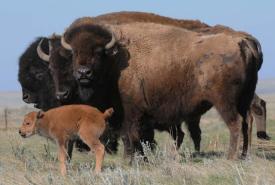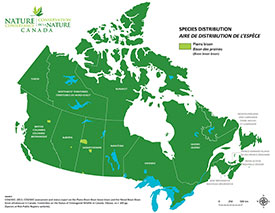
Plains bison (Photo by Steve Zack)
Plains bison
What does it look like?
A symbol of determination and indomitable spirit, bison are distinguished from other cloven-hoofed ruminants by their massive woolly heads, curved black horns and forequarters. They are North America's largest land mammal and can grow to be almost two metres tall and weigh over 800 kilograms. Despite their size, bison are surprisingly agile, running at speeds of up to 60 kilometres per hour, turning faster than a horse and able to jump two metres straight up from a standing position.
Where is it found?
Historically, this herbivorous grazer’s Canadian range extended across the Prairies, preferring open lands and choosing habitat according to the species' nutritional needs and to avoid predators.
How does it behave?
Bison are very protective of one another and act as a group when threatened, calling out to each other through a series of grunts and snorts. They are also known to protect their calves ferociously.
What is its life cycle?
Bison evolved to synchronize the births of their calves each spring to allow the offspring time to gain strength before winter's arrival and make it harder for predators to pick them off individually. When born, they are reddish-orange in colour, blending in with early spring grasses. They begin to turn brown, the colour of mature bison, at 10 weeks. The calves stay close to their mothers for the first month before branching out to play with other calves. At one year, they are weaned from their mothers, reaching sexual maturity at two to three years.
What is its conservation status?
In the early 1800s, an estimated 60 million wild plains bison roamed the continent, but by the turn of the century over-hunting had decreased their numbers to a mere 300. As settlers headed west, close to 90 per cent of Canada's original grasslands were converted for agriculture or other purposes.
What is NCC doing to protect habitat for this species?
Since reintroducing the species to its native habitat in December 2003, the Nature Conservancy of Canada (NCC) has continued to manage a herd of genetically pure plains bison at Old Man on His Back Prairie and Heritage Conservation Area (OMB) in southwestern Saskatchewan. The herd currently numbers 85 cows and six breeding bulls. NCC intends to increase the herd's size to about 100 animals and has developed a 10-year management plan for the OMB bison herd to ensure that the herd continues to thrive into the future.
NCC manages OMB as a working ranch, and as a positive example of how agriculture and conservation complement each other. The species' distinct grazing patterns create a mosaic of varying habitats that suit many grassland species' requirements, thus increasing biodiversity
Want to support wildlife species and their habitat? With your donation, you are accelerating the pace of conservation and helping find solutions to the twin crises of rapid biodiversity decline and climate change. Learn more >.





